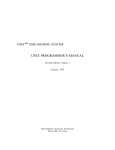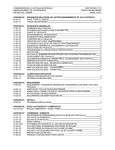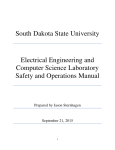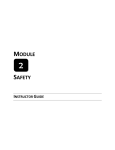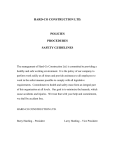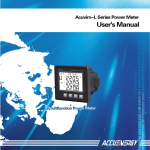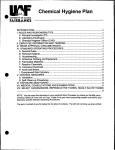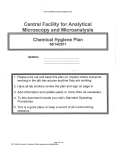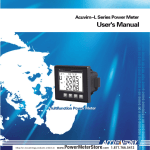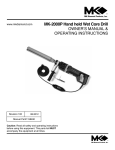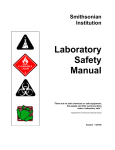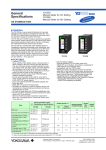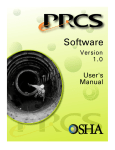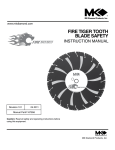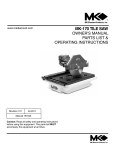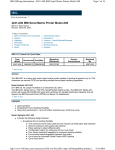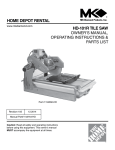Download Injury and Illness Prevention Program (IIPP)
Transcript
GLENN COUNTY INJURY AND ILLNESS PREVENTION PROGRAM March 27, 2006 Revised August 28, 2009 1 TABLE OF CONTENTS SAFETY POLICY STATEMENT ..................................................................................... 3 I. MANAGEMENT.................................................................................................... 3 II. EMPLOYEES ......................................................................................................... 3 RESPONSIBILITIES ......................................................................................................... 4 I. COUNTY SAFETY OFFICER .............................................................................. 4 II. MANAGEMENT.................................................................................................... 4 IlI. SUPERVISORS ...................................................................................................... 4 IV. EMPLOYEES ......................................................................................................... 5 V. COUNTY SAFETY AND HEALTH COMMITTEE ............................................ 5 SAFETY COMMUNICATION.......................................................................................... 7 EMPLOYEE COMPLIANCE .......................................................................................... 10 SAFETY AND HEALTH TRAINING ............................................................................ 11 HAZARD REPORTING PROGRAM.............................................................................. 13 I. PURPOSE ............................................................................................................. 13 II. IDENTIFICATION METHODS .......................................................................... 13 IDENTIFYING AND CORRECTING UNSAFE CONDITIONS ................................... 15 I. SUGGESTED PROCEDURES ............................................................................ 15 II. IMPENDING HAZARD ...................................................................................... 15 ACCIDENT INVESTIGATIONS .................................................................................... 16 I. REPORTING ........................................................................................................ 16 II. INVESTIGATION ................................................................................................ 17 RECORDKEEPING ......................................................................................................... 18 CODES OF SAFE PRACTICES ...................................................................................... 24 I. PURPOSE ............................................................................................................. 24 II. GENERAL SAFETY ............................................................................................ 24 III. OFFICE SAFETY................................................................................................. 26 IV. HOUSEKEEPING ................................................................................................ 27 V. PROTECTIVE EQUIPMENT AND CLOTHING ............................................... 29 VI. FIRE PREVENTION ............................................................................................ 31 VII. MATERIAL HANDLING .................................................................................... 33 VIII.HAND AND POWER TOOLS ............................................................................ 36 IX. LADDERS ............................................................................................................ 42 X. COUNTY VEHICLES AND MOBILE EQUIPMENT ....................................... 43 APPENDIX SECTIONS................................................................................................... 46 EMPLOYEE INSTRUCTION OR TRAINING REQUIREMENTS IN CCR T8 ....... 46 CCR T8 CONSTRUCTION SAFETY ORDERS .................................................... 46 CCR T8 GENERAL INDUSTRY SAFETY ORDERS ........................................... 46 EXHIBITS ........................................................................................................................ 52 REFERENCES AND RESOURCE INFORMATION ..................................................... 53 2 SAFETY POLICY STATEMENT It is the Policy of the Board of Supervisors of Glenn County (County) to establish guidelines and procedures for the maintenance of an on-going Injury and Illness Prevention Program (IIPP), in compliance with the California Code of Regulations and General Industry Standards. The Board of Supervisors is committed to a responsible and successful program that includes the identification and correction of hazards and training of employees in safe work practices. The County’s objective is a safe and healthy program that will encourage safe work practices for the protection of employees, the general public, and County/private property. I. MANAGEMENT The personal safety and health of each County employee is essential. Occupational injuries and illnesses not only cause employees physical and mental pain, but are also costly in terms of expenditures, lost time, and production. Effective accident prevention is directly related to better use of taxpayer’s money. Prevention of occupational injuries and illnesses is of such consequence that it will be given precedence over operating productivity. If the job function cannot be performed safely, the work shall be temporarily interrupted until the job can be made safe. In keeping with high safety standards, management will ensure all mechanical and physical activities are performed with safety and health first. II. EMPLOYEES Each department shall follow the County’s IIPP and implement a comprehensive safety program. The goal of the IIPP is to minimize the occurrence and gravity of employee occupational related injuries and illnesses. To meet this goal, all employees must adopt proper attitudes and practices towards injury and illness prevention. The IIPP cannot succeed without the cooperation of all employees. 3 RESPONSIBILITIES I. COUNTY SAFETY OFFICER The County Safety Officer has been assigned the responsibility of the overall direction of the County’s IIPP and acts as a safety advisor for the County. The County Safety Officer may assist departments in the implementation of and compliance with the California Occupational Safety and Health (Cal/OSHA) Act, provide required reporting forms as necessary, and provide safety coordination with enforcement agencies, civic groups, and private organizations, as may be necessary. II. MANAGEMENT Each department is responsible for implementing the County’s IIPP, as well as their department’s Code of Safe Practices, with all levels of management participating, to ensure that employees are aware of the safe work practices for their job assignment and work area. Managers are responsible for maintaining a safe work environment and ensuring that materials, equipment, and machines used in their departments are hazard free and adequate control measures have been provided. Management is also responsible to provide information, instruction, training, and supervision, as required, to ensure occupational safety and health. The degree of effort and focus needed will vary depending on the nature of the work performed. While they may assign responsibility and delegate authority to others, they are accountable for those preventable oversights and errors within their areas that result in injury, illness, or property damage affecting employees, the general public, or County/private property. (County department heads and divisions are listed on Exhibit A along with their telephone numbers.) IlI. SUPERVISORS Supervisors carry a great deal of influence. With their support, management can be assured of the effective implementation of the County’s IIPP and their department’s Code of Safe Practices. They have a moral and professional responsibility to safeguard, educate, and train those who have been placed under their direction. They are generally responsible for creating a safe and healthy work environment and for integrating hazard recognition and control into all aspects of work activities. They are the eyes and ears of the workplace control system. They must be aware of what is happening in their respective areas, how tasks are being performed, and under what condition. Supervisors are also responsible for encouraging proper attitudes toward safe job performance in themselves and in their employees. Their leadership and influence should assure that safety and health standards are enforced and upheld in each individual area, and that standards and enforcement are uniform throughout the work place. 4 IV. EMPLOYEES Employees are the success of the County’s IIPP and individual department’s Code of Safe Practices. County employees have a duty to ensure their own safety and the safety of others who can be affected by their work activities. County employees also have a duty to cooperate with management and the department’s Safety Representative at the work place on all matters relating to safety and health. Learning all standard operating procedures for their area of responsibility and wearing required safety protection will minimize work related injuries and illnesses. V. COUNTY SAFETY AND HEALTH COMMITTEE The County Safety and Health Committee (Committee) consists of one safety representative from each department to be designated by the department head. The Committee will meet quarterly, or more frequently as necessary, to conduct business. The functions of the Committee may include but are not limited to: A. Program Assessment - Review and assess the effectiveness of the County’s overall IIPP and departmental programs. B. Monitor for Trends - Evaluate significant accident/injury reports and statistics to identify trends and initiate corrective action. C. Review Training - Implement necessary programs to satisfy education/training requirements. D. Make Recommendations - Discuss and review safety conditions, complaints, and accidents. Make recommendations to the County Board of Supervisors, County Safety Officer and department heads on actions necessary to comply with safety and health regulations. E. Conduct Safety Inspections - Conduct safety inspections to identify existing and potential hazards (General Safety Inspection Checklist labeled Exhibit B). The findings are reported to the department’s management for follow up. F. Initiate Special Investigations - Upon the recommendation of the Safety Committee, initiate special investigations of major accidents/injuries or identified safety hazards. In such instances, the Committee may recommend that an investigating team be appointed by the Committee Chairperson. G. Review Accidents - Review County-owned and privately-owned vehicle accidents for adequate investigation and corrective measures to prevent recurrence using the Accident Investigation Form (Exhibit C). H. Review and Implement Suggestions or Requests - All safety suggestions or requests forwarded by department safety committees or referred through the Employee Hazard Reporting Program shall be reviewed and evaluated by the Committee. Action shall be initiated where appropriate. I. Committee Membership Includes: 1. Chairperson: County Safety Officer 2. Vice-Chairperson (to be appointed by the Committee) 3. Secretary 4. Members: 5 a. b. c. d. e. f. g. h. i. j. k. l. m. n. o. p. Agricultural/Air Pollution Animal Control Assessor’s Office Child Support Division Clerk/Recorder’s Office Cooperative Extension County Administrative Office/Clerk of the Board County Counsel’s Office Department of Finance District Attorney Health Services Agency Human Resource Agency Planning and Public Works Agency Probation Public Guardian’s Office Sheriffs Office 6 SAFETY COMMUNICATION COMMUNICATION The personal safety and health of each County employee is a priority. Regular communication about workplace hazards reinforces this priority. Management is responsible for communicating with all employees about safety and health issues in a form readily understandable by all employees. Management/supervisors are also responsible for ensuring that all employees receive safety training and information, no less than monthly. Relevant safety information shall be posted as needed in a conspicuous place where notices to employees are customarily posted. This may include general safety information, or specific information related to an area or particular operation. Safety information shall be disbursed to employees as the need arises. The responsibilities for health and safety are shared among management, supervisors, and employees. Employees are encouraged to talk with management and/or their supervisor regarding health and safety concerns. Employees can also contact the County Safety Officer regarding any potential health or safety hazard that may exist in a work area. Employees may anonymously submit safety suggestions for hazard identification, complaints, etc., on the “Employee Report of Unsafe Condition or Hazard” form (Exhibit D). This form may also be sent directly to the County Safety Officer. No employee will be retaliated against for reporting hazards or potential hazards or for making suggestions related to safety.1 Employees are advised that adherence to safe work practices and proper use of personal protective equipment are an integral part of their workplace safety. Supervisors are responsible for ensuring that employees are supplied access to hazard information pertinent to their area(s) of assignment. Information concerning the health and safety hazards is available from a number of sources. These sources include, but are not limited to Material Safety Data Sheets (MSDS), equipment operating manuals, Risk Management, Container Labels, and Employee Postings. A. Material Safety Data Sheets (MSDS) MSDS provide information on potential chemical or product hazards. Hard copies of MSDS for chemicals used in the department are available in the MSDS book located in your department. If an MSDS is found to be missing, a new one can be obtained by faxing a written request to the manufacturer. A copy of this request should be kept until the MSDS arrives. 1 Department of Industrial Relations, California Code of Regulations, Title 8, Section 3202, Injury and Illness Prevention Program, http://www.dir.ca.gov/title8/3203.html. 7 B. Equipment Operating Manuals All equipment shall be operated in accordance with manufacturer’s instructions as specified in the equipment’s operating manual. Copies of operating manuals will be kept with each piece of equipment in the department. Persons who are not familiar with the equipment operation and its potential hazards are not authorized to operate that equipment until training is received from an experienced operator or supervisor. C. Risk Management It is the County’s policy to provide a safe and healthy work environment for all its employees. Preventing the conditions, practices, and attitudes that contribute to unforeseen or accidental losses of all types can be accomplished through identification, examination, and coordination of risk controls to efficiently and effectively minimize the adverse effects of accidental losses to County resources and productivity. D. Container Labels Accidents and mix ups can be avoided through labeling. Manufacturers label their products with an overview of the hazards associated with the product’s use. All containers holding chemical or commercial substances with chemical hazards must be labeled appropriately. Secondary containers should be labeled with the chemical name, concentration, and list of associated hazards. E. Employee Postings State and federal laws and regulations require that California employers conspicuously display a number of posters where they can be read by employees. Such notice or notices shall be posted in each establishment in a conspicuous place or places where notices to employees are customarily visited. Please contact the Glenn County Personnel Director to ensure that your department meets their posting requirements. Additional information regarding State and Federal posting requirements can be located at the following web sites: California Chamber of Commerce, Required Posting FAQs, http://www.calbizcentral.com/Store/HRTips/Pages/06RNFAQs.aspx. Department of Industrial Relations, Division of Labor Standards Enforcement, Workplace Postings, http://www.dir.ca.gov/wpnodb.html. Department of Industrial Relations, Division of Occupational Safety and Health, “Publications,” © 2003 State of California, <http://www.dir.ca.gov/DOSH/puborder.asp>,(November 2003). 8 Department of Fair Employment and Housing, “Publications,” http://www.dfeh.ca.gov/DFEH/Publications/publications.aspx. U.S. Department of Labor, Occupational Safety and Health Administration, n.d., <http://www.osha.gov/pls/publications/pubindex.list>, (November 2003). 9 EMPLOYEE COMPLIANCE The County will strive to provide each employee with a healthy and safe workplace. Each department is responsible for ensuring that employees comply with safety and health work practices. Any violation of, or deviation from, the County’s safety rules and regulations may be considered just cause for and result in disciplinary action in accordance with the County Code and Memorandum of Understanding, if applicable. If an employee is found to be grossly negligent, immediate discharge may result. Any employee who has caused an accident because of gross negligence, carelessness or horseplay will be suspended and/or terminated. Timely correction of workplace hazards will be tracked by the Glenn County Safety Committee, which will receive and review reports of unsafe conditions, workplace inspection reports and injury reports. 10 SAFETY AND HEALTH TRAINING All employees shall have safety and health training orientation on general and job related work practices. All supervisors must ensure that their employees receive appropriate training for job related hazards and the proper precautions for protection against those hazards. This training can be documented using the “Glenn County Safety and Health Orientation” form (Exhibit E). TRAINING It is each supervisor’s responsibility to know the hazards related to their employees’ job tasks and to ensure that they receive proper training. All employees shall receive general and job-specific orientation. This orientation takes place when the IIPP is first established, when new employees are hired, when employees are given a new job assignment on which they have not previously been trained, or whenever a supervisor is made aware of a new or previously unrecognized hazard.2 Suggested training topics that may be appropriate include but are not limited to: A. B. C. D. E. F. G. H. I. J. K. L. Basic First Aid Blood Borne Pathogens Confined Space Defensive Driving Emergency Response Ergonomics Fire Safety and Fire Extinguisher Use Hazard Communication 1. Training on MSDS 2. Chemical Hazards 3. Container Labeling Hearing Conservation Personal Protective Equipment Safe Lifting Techniques and Back Care Slips, Trips, and Falls In addition to Tailgate and formal safety training sessions, Glenn County has implemented MemberLink, and on-line loss prevention program. MemberLink provides training on many of the subjects listed above. For more information regarding MemberLink training contact your department’s Safety Representative or the County Safety Officer at 530-934-6455. 2 Department of Industrial Relations, California Code of Regulations, Title 8, Section 3203, Injury and Illness Prevention Program, <http://www.dir.ca.gov/title8/3203.html>, . 11 Additional safety and health topics can be obtained by contacting the County’s Safety Officer or via the following links: Department in Industrial Relations, Division of Occupational Safety and Health, Publications, <http://www.dir.ca.gov/dosh/puborder.asp>. U.S. Department of Labor, Occupational Safety & Health Administration, OSHA Publications, Posters, and Online Order Form, n.d., <http://www.osha.gov/pls/publications/pubindex.list>. California State Insurance Compensation Fund, Tailgate Topics, <http://www.statefundca.com/safety/safetymeeting/SafetyMeetingTopics.aspx> 12 HAZARD REPORTING PROGRAM I. PURPOSE An employee Hazard Reporting Program is established to provide a means for individual employees to report previously unrecognized hazards that could cause employee injury/illness, death, damage to County property, or injury/accident to a public patron on County property (“Employee Report of Unsafe Condition of Hazard” Exhibit D). Methods used to identify hazardous conditions or practices may involve several different resources including relevant safety orders, job safety analysis, self-inspection checklist, and review of accident statistics. II. IDENTIFICATION METHODS A. Periodic inspections can be used to identify and evaluate workplace hazards. An analysis should be performed when: 1. New equipment, chemicals, processes, and/or procedures are introduced in the workplace. 2. Identification of a previously unrecognized hazard. 3. An occupational injury or illness occurs. 4. Workplace conditions warrant an analysis. B. Two forms are available for use with a hazard reporting program: 1. Job Hazard Analysis – This is a technique used to identify the potential hazards associated with all of the steps of a specific job/task. Upon completion, supervisors may use the job hazard analysis as a training tool (“Job Safety Analysis Form” Exhibit F). 2. Periodic Safety Inspections - Inspections are conducted depending on the necessity and type of inspection to be completed (“General Safety Inspection Checklist” Exhibit B). The following can be used as a guideline: a. Daily - A high hazard or frequent change in workplace operations or equipment. b. Weekly - Flammable storage areas and construction sites. c. Monthly - Workshops, fleet services, parking lots, grounds, and maintenance areas. d. Bi-annually - Offices d. Annual - A more comprehensive inspection. C. Employees are encouraged to participate in reporting unsafe workplace hazards by utilizing the “Employee Report of Unsafe Condition or Hazard” Form (Exhibit D). Employees may submit this form to their immediate Supervisor or forward to the County Safety Officer for investigation. This form may be submitted anonymously. D. Departments can obtain assistance, through the County Safety Officer, in developing corrective actions by submitting an “Employee Report of Unsafe Condition or Hazard” (Exhibit D) to the Committee. 13 E. A copy of all completed “Job Hazard Analysis”, “Periodic Safety Inspections Check Sheet” and ‘Employee Report of Unsafe Condition or Hazard” shall be forwarded to the County Safety Officer for review. 14 IDENTIFYING AND CORRECTING UNSAFE CONDITIONS Steps to correct workplace hazards discovered as a result of a job hazard analysis, periodic safety inspection, or during normal operations must be implemented by the supervisor overseeing the work area. Based upon the severity of the workplace hazard, supervisors shall be responsible to initiate all necessary action in an appropriate time frame. I. SUGGESTED PROCEDURES Procedures that can be used to correct an unsafe workplace hazard include, but are not limited to: A. Using proper lockout tag out procedures for unsafe equipment and providing employees with alternatives until the unsafe equipment is repaired. B. Reinforcing the necessity of utilizing appropriate personal protective equipment and ensuring its availability. C. Stopping unsafe work practices and retraining employees on proper processes and procedures before resuming work. D. Barricading areas where hazardous spills or other hazards have occurred and immediately reporting the hazards to the proper personnel. Supervisors should use the “Employee Report of Unsafe Condition or Hazard” (Exhibit D) to record the action taken to correct a workplace hazard. Supervisors can request assistance, through the County Safety Officer, in developing corrective action by submitting the “Employee Report of Unsafe Condition or Hazard” (Exhibit D) to the Committee. II. IMPENDING HAZARD If the hazard poses an immediate danger, the operation shall be safely stopped until the necessary corrective action can be taken. Management and the County Safety Officer shall be immediately notified of the stoppage. If the hazard cannot be immediately corrected without endangering employees, property, or the general public, all personnel, except those qualified and necessary to correct the conditions, shall be removed from the area. Necessary equipment and safeguards shall be made available to correct the condition. 15 ACCIDENT INVESTIGATIONS I. REPORTING Employees shall immediately notify their supervisor of any work-related injury or illness. First aid and medical treatment shall be provided immediately as required by the nature of the injury. The injured employee’s supervisor shall contact Medcor at 1-800-775-5866 and report the injury. In a life-threatening or limb-threatening situation, contact 911 or transport the injured employee to the Emergency Room immediately. The injured employee’s supervisor shall contact Medcor after the situation has stabilized. In a non-emergency situation, the injured employee’s supervisor shall contact Medcor before the employee leaves the worksite. Medcor will triage the situation, advise the employee and begin the required paperwork. If the employee has previously predesignated their personal physician for treatment of work-related injuries or illnesses they should report this to Medcor. Copies of the Employer’s Report of Occupational Injury or Illness (Form 5020), Employee’s Claim for Workers Compensation Benefits (DCW 1) and Medcor Report of Injury will be sent by Medcor to Glenn County Personnel staff, Golden State Risk Management Authority, a pre-designated departmental representatives, as well as the Glenn County Safety Officer. Departments must provide the injured employee an “Employee’s Claim for Workers’ Compensation Benefits” (DWC Form 1) within 24 hours of their knowledge of the workrelated injury. California law requires employers to report within five (5) days of its knowledge every occupational injury or illness which results in lost time beyond the date of the incident or requires medical treatment beyond first aid using the “Employer’s Report of Occupational Injury or Illness” (Form 5020). All serious injuries must be reported to Cal OSHA as soon as practically possible but not longer than eight (8) hours after the employer knows or with diligent inquiry would have known of the incident. An injury is considered serious per Cal OSHA if it results in one of the following: Hospitalization of more than 24 hours Amputation/Dismemberment Disfigurement (Significant scarring) Death Should a serious injury occur contact the Glenn County Safety Officer at 530-934-6455, Cal OSHA should also be contacted at (916) 263-2800. If the injured employee seeks medical treatment beyond first aid, the supervisor shall obtain a “Physician’s Statement to Support Leave or Return From Leave” Form (Exhibit I) before allowing the employee to return to work. Work accommodations may be 16 necessary for the employee, as the health care provider may require work restrictions/limitations. II. INVESTIGATION Each department shall be responsible to determine and correct, if applicable, the contributing factors of an employee accident or incident. The investigation is performed on the “Accident Investigation Form” (Exhibit C) within twenty-four (24) hours of the occurrence. Procedures that can be used to investigate accident or incident causes include: A. B. C. D. Interview injured employee(s) Interview all witnesses Determine the accident’s contributing factors Review departmental procedures and policies to determine whether or not they were followed and are sufficient E. Consider additional contributing factors (i.e., equipment, hazardous substances, co-worker, etc.) F. Implement corrective action necessary to prevent reoccurrence G. Record all findings on the “Accident Investigation Form” (Exhibit C) A copy of the completed “Accident Investigation Form” is submitted to the County Safety Officer for review. The County Safety Officer will follow-up with the supervisor if further investigation and/or corrective action is deemed necessary. 17 RECORDKEEPING Departments should retain records to demonstrate a good faith effort to achieve an effective IIPP safety program. These records should be maintained on file in each department as they pertain to that department’s operations. They should be maintained for a period of one year from the time of generation, or longer, if deemed necessary by the Department Head. These records include but are not limited to the following: Records of inspections and investigations including dates, persons who conducted the inspections or investigations, unsafe work practices or conditions identified, corrective actions taken and dates of correction. Documentation of training provided to employees, including new hire instruction and follow-up training required by changes in operations or the identification of a previously unknown hazard. These should include the names of all attendees and instructors, the date of the training, and material covered. Other documents related to the IIPP that will be kept on file with the Safety Officer include but are not limited to the following: Employee Report of Unsafe Condition or Hazard Form Job Hazard Analysis Periodic Safety Inspection Check Sheets Accident/Incident Investigation Reports Safety Committee Meeting Minutes 18 CALIFORNIA CODE OF REGULATIONS, TITLE 8, SECTION 3203, INJURY AND ILLNESS PREVENTION PROGRAM (a) Effective July 1, 1991, every employer shall establish, implement and maintain an effective Injury and Illness Prevention Program (Program). The Program shall be in writing and, shall, at a minimum: (1) Identify the person or persons with authority and responsibility for implementing the Program. (2) Include a system for ensuring that employees comply with safe and healthy work practices. Substantial compliance with this provision includes recognition of employees who follow safe and healthful work practices, training and retraining programs, disciplinary actions, or any other such means that ensures employee compliance with safe and healthful work practices. (3) Include a system for communicating with employees in a form readily understandable by all affected employees on matters relating to occupational safety and health, including provisions designed to encourage employees to inform the employer of hazards at the worksite without fear of reprisal. Substantial compliance with this provision includes meetings, training programs, posting, written communications, a system of anonymous notification by employees about hazards, labor/management safety and health committees, or any other means that ensures communication with employees. Exception: Employers having fewer than 10 employees shall be permitted to communicate to and instruct employees orally in general safe work practices with specific instructions with respect to hazards unique to the employees' job assignments as compliance with subsection (a)(3). (4) Include procedures for identifying and evaluating work place hazards including scheduled periodic inspections to identify unsafe conditions and work practices. Inspections shall be made to identify and evaluate hazards: (A) When the Program is first established; Exception: Those employers having in place on July 1, 1991, a written Injury and Illness Prevention Program complying with previously existing section 3203. (B) Whenever new substances, processes, procedures, or equipment are introduced to the workplace that represent a new occupational safety and health hazard; and (C) Whenever the employer is made aware of a new or previously unrecognized hazard. 19 (5) Include a procedure to investigate occupational injury or occupational illness. (6) Include methods and/or procedures for correcting unsafe or unhealthy conditions, work practices and work procedures in a timely manner based on the severity of the hazard: (A) When observed or discovered; and, (B) When an imminent hazard exists which cannot be immediately abated without endangering employee(s) and/or property, remove all exposed personnel from the area except those necessary to correct the existing condition. Employees necessary to correct the hazardous condition shall be provided the necessary safeguards. (7) Provide training and instruction: (A) When the program is first established; Exception: Employers having in place on July 1, 1991, a written Injury and Illness Prevention Program complying with the previously existing Accident Prevention Program in Section 3203. (B) To all new employees; (C) To all employees given new job assignments for which training has not previously been received; (D) Whenever new substances, processes, procedures or equipment are introduced to the workplace and represent a new hazard; (E) Whenever the employer is made aware of a new or previously unrecognized hazard; and, (F) For supervisors to familiarize themselves with the safety and health hazards to which employees under their immediate direction and control may be exposed. (b) Records of the steps taken to implement and maintain the Program shall include: (1) Records of scheduled and periodic inspections required by subsection (a)(4) to identify unsafe conditions and work practices, including person(s) conducting the inspection, the unsafe conditions and work practices that have been identified and action taken to correct the identified unsafe conditions and work practices. These records shall be maintained for at least one (1) year; and Exception: Employers with fewer than 10 employees may elect to maintain the inspection records only until the hazard is corrected. 20 (2) Documentation of safety and health training required by subsection (a)(7) for each employee, including employee name or other identifier, training dates, type(s) of training, and training providers. This documentation shall be maintained for at least one (1) year. EXCEPTION NO. 1: Employers with fewer than 10 employees can substantially comply with the documentation provision by maintaining a log of instructions provided to the employee with respect to the hazards unique to the employees' job assignment when first hired or assigned new duties. EXCEPTION NO. 2: Training records of employees who have worked for less than one (1) year for the employer need not be retained beyond the term of employment if they are provided to the employee upon termination of employment. EXCEPTION NO. 3: For Employers with fewer than 20 employees who are in industries that are not on a designated list of high-hazard industries established by the Department of Industrial Relations (Department) and who have a Workers' Compensation Experience Modification Rate of 1.1 or less, and for any employers with fewer than 20 employees who are in industries on a designated list of low-hazard industries established by the Department, written documentation of the Program may be limited to the following requirements: A. Written documentation of the identity of the person or persons with authority and responsibility for implementing the program as required by subsection (a)(1). B. Written documentation of scheduled periodic inspections to identify unsafe conditions and work practices as required by subsection (a)(4). C. Written documentation of training and instruction as required by subsection (a)(7). Exception No. 4: Local governmental entities (any county, city, city and county, or district, or any public or quasi-public corporation or public agency therein, including any public entity, other than a state agency, that is a member of, or created by, a joint powers agreement) are not required to keep records concerning the steps taken to implement and maintain the Program. Note 1: Employers determined by the Division to have historically utilized seasonal or intermittent employees shall be deemed in compliance with respect to the requirements for a written Program if the employer adopts the Model Program prepared by the Division and complies with the requirements set forth therein. Note 2: Employers in the construction industry who are required to be licensed under Chapter 9 (commencing with Section 7000) of Division 3 of the Business and Professions Code may use records relating to employee training provided to the employer in connection with an occupational safety and health training program approved by the Division, and shall only be required to keep records of 21 those steps taken to implement and maintain the program with respect to hazards specific to the employee's job duties. (c) Employers who elect to use a labor/management safety and health committee to comply with the communication requirements of subsection (a)(3) of this section shall be presumed to be in substantial compliance with subsection (a)(3) if the committee: (1) Meets regularly, but not less than quarterly; (2) Prepares and makes available to the affected employees, written records of the safety and health issues discussed at the committee meetings and, maintained for review by the Division upon request. The committee meeting records shall be maintained for at least one (1) year; (3) Reviews results of the periodic, scheduled worksite inspections; (4) Reviews investigations of occupational accidents and causes of incidents resulting in occupational injury, occupational illness, or exposure to hazardous substances and, where appropriate, submits suggestions to management for the prevention of future incidents; (5) Reviews investigations of alleged hazardous conditions brought to the attention of any committee member. When determined necessary by the committee, the committee may conduct its own inspection and investigation to assist in remedial solutions; (6) Submits recommendations to assist in the evaluation of employee safety suggestions; and (7) Upon request from the Division, verifies abatement action taken by the employer to abate citations issued by the Division. Note: Authority cited: Sections 142.3 and 6401.7, Labor Code. Reference: Sections 142.3 and 6401.7, Labor Code. HISTORY 1. New section filed 4-1-77; effective thirtieth day thereafter (Register 77, No. 14). For former history, see Register 74, No. 43. 2. Editorial correction of subsection (a)(1) (Register 77, No. 41). 3. Amendment of subsection (a)(2) filed 4-12-83; effective thirtieth day thereafter (Register 83, No. 16). 4. Amendment filed 1-16-91; operative 2-15-91 (Register 91, No. 8). 22 5. Editorial correction of subsections (a), (a)(2), (a)(4)(A) and (a)(7) (Register 91, No. 31). 6. Change without regulatory effect amending subsection (a)(7)(F) filed 10-2-92; operative 11-2-92 (Register 92, No. 40). 7. Amendment of subsection (b)(2), Exception No. 1, new Exception No. 3 through Exception No. 4, Note 2, and amendment of subsection (c)(2) filed 9-13-94; operative 9-13-94 pursuant to Government Code section 11346.2 (Register 94, No. 37). 8. Editorial correction of subsections (a)(6)(A) and (a)(7)(A) (Register 95, No. 22). 9. Amendment of subsections (b)(1)-(2) and (c)(2) filed 6-1-95; operative 7-3-95 (Register 95, No. 22). 10. Editorial correction of subsection (a)(4) (Register 2002, No. 46). The above information is provided free of charge by the Department of Industrial Relations, Division of Occupational Safety and Health (DOSH) from its web site at <http://www.dir.ca.gov/samples/search/query.htm> 23 CODE OF SAFE PRACTICES I. PURPOSE For the protection and safety of all employees, property, and the public, the County has developed the following Code of Safe Practices as a guide. Not all of the safe practices in this section will pertain to County operations at all times. Employees shall refer to their department for additional Code of Safe Practices, specific guidelines, trainings, and instruction for their areas of responsibility. II. GENERAL SAFETY Safety is part of every work plan and is just as important as all other operational considerations. The following general safety procedures may be used as a guide: A. General Safe Work Practices 1. Departmental safe work practices shall be followed by all employees. Supervisors are responsible for proper training and instruction to their employees, inspection of equipment and tools, and enforcement of all departmental safety rules. 2. Employees shall immediately notify their supervisor of any work-related injury or illness. First aid and medical treatment shall be provided immediately as required by the nature of the injury. The injured employee’s supervisor shall contact Medcor at 1-800-775-5866 and report the injury. The department has twenty-four (24) hours to provide the employee, either personally or by first-class mail, the “Employee’s Claim for Workers’ Compensation Benefits” (DWC Form 1 [Exhibit G]). 3. All incidents, whether or not involving personal injury or property damage, should be reported to your Supervisor immediately. “Near misses” are accidents waiting to happen. 4. Horseplay and rough housing should not be tolerated at the worksite. Practical jokes, throwing things, running in aisles and stairways, jumping from elevated surfaces, and distracting others at work is dangerous. 5. Use handrails on stairs or elevated areas. 6. Maintain good housekeeping at the jobsite. Clean up grease, oil, and water spills immediately. 7. Do not block aisles and fire exits. Keep loose materials off stairs and walkways. 8. Employees reasonably believed to be under the influence of alcohol or drugs, upon order of the employer, shall not engage in further work until reasonable, appropriate, and safe action can be taken to ensure the safety of the work place. 9. Smoking is not allowed in any County building. Smoking is allowed outside in designated areas only. These areas may not be within 20 feet of a main exit, entrance or operable window. 24 10. Failure by an employee to comply with the safety rules may be subjected to corrective and/or disciplinary action. 11. Work with care and good judgment at all times to avoid accidents. Work at a speed consistent with safety. 12. Stand on a firm work surface such as a ladder or step stool. Chairs, tables, desks, boxes, pallets, etc., are unsafe work platforms. 13. Inspect tools and equipment before use. Defects should be reported to the supervisor and other potential users immediately. Avoid defective tools and equipment. 14. Obey all warning tags and signs. 15. Employees shall not operate machines or equipment until proper training and instruction has been provided. 16. Do not operate machinery or equipment without guards. 17. Remove or clinch protruding nails, staples, or steel straps. 18. Wear appropriate clothing and footwear for the type of work to be performed. Loose clothing or personal equipment near moving parts or equipment is hazardous. 19. Jewelry (rings, neck chains, bracelets, etc.) should not be worn in work that requires climbing, materials handling, or operating mechanical equipment. 20. Wear personal protective equipment as necessary or required. 21. Working under a suspended load is hazardous 22. Follow safe work practices to ensure the safety and health of all employees, the general public, and County/private property. 25 III. OFFICE SAFETY Many hazards exist in an office environment. The most common injuries and illnesses associated with office automation and computer usage is repetitive motion injuries. Without taking proper precautions to ensure a safe office environment, injuries such as these will slowly build over time. Recognizing potential and imminent office hazards is essential for proper safe work practices. General office safety practices could be used for a variety of purposes, including but not limited to: A. Office Safety Procedures 1. Practice good housekeeping at the desk and work area (pick up pencils, paper clips, pushpins, wipe up spills, etc). 2. Do not use chairs as a ladder. 3. Do not store heavy materials and boxes in high locations. 4. Letter openers, scissors, and other sharp objects should be stored separately. 5. Exercise caution when operating a paper cutter or shredding equipment. Keep hands, fingers, and loose clothing clear from the cutting edge. 6. Close file drawers when not in use. Avoid opening more than one drawer at a time. Load a file cabinet from the bottom up, in order to balance its load. 7. Maintain office furniture (desks, chairs, tables, etc.) in good working order. Repair defective furniture as necessary. 8. Well-designed workstations ensure that employees can perform their jobs in optimal comfort, without experiencing the unnecessary physical and mental fatigue that can slow work performance, reduce accuracy, or cause repetitive stress injuries. Ensure that workstations are ergonomically correct by requesting an ergonomic evaluation through the County’s Safety Officer using the “Ergonomic Evaluation Request Form” (Exhibit J). The Safety Officer can be reached at 530-934-6455 (phone) or 530-934-6457 (fax) 9. Exercise caution when opening or approaching doors. 10. Maintain aisles clear of items that can create a tripping hazard, such as wastebaskets, electrical cords, chairs, etc. 11. Ensure that electrical cords are in good working order. Replace cords where the wire is exposed to avoid electrical shock. 12. Ensure that equipment is UL approved and/or grounded. Immediately unplug defective equipment and promptly report it to your supervisor. 26 IV. HOUSEKEEPING A safe workplace is readily identified with good housekeeping. Good housekeeping practices prevent accidents and injuries, saves space, time, and materials. When equipment and materials are stored properly, accidents and potential property damages (i.e., fires caused by improper storage of flammable materials) are prevented. When a workplace is clean, orderly, and free of obstruction; work can get done safely and properly.3 General recommended housekeeping practices are as follows: A. Housekeeping/Hazards 1. Observe good housekeeping by keeping work areas clear of debris, trash, and unused material. 2. Familiarize yourself with the required safety precautions. 3. Immediately report any unsafe conditions or equipment to your supervisor. 4. Immediately report all accidents and/or injuries to your supervisor. 5. Immediately clean all spilled oil, grease, water, and other liquids. 6. Do not store materials and supplies against doors, exits, fire ladders, or fire extinguisher stations. Doors shall remain accessible at all times. 7. Do not store materials or supplies on top of lockers, boxes, or other moveable containers at a height where they are not visible from the floor. 8. Stack or pile materials in such a way that each level is resting securely on the one below it. Use proper blocking when necessary and do not exceed the height recommended by your department. Report any unsafe stacks to your supervisor. 9. Maintain tools, equipment, machinery, and work areas in a clean and safe manner. Return tools and equipment to their proper storage area when not in use. Report any unsafe conditions and defects to your supervisor. 10. Follow lock-out/tag-out procedures when performing maintenance or repair on equipment or machinery. 11. Keep materials, equipment, electrical cords, and supplies out of aisles and walkways. 12. Remove or clinch protruding nails, staples, or steel straps. 13. Sharp or pointed materials should be stored to prevent someone from coming in contact with them. 14. Place trash and scrap in proper waste containers. 15. Place or store oily and greasy rags in appropriate containers. 16. Ensure that electrical cords are in good working order. Replace cords where the wire is exposed to avoid electrical shock. 17. Barricade and post in areas where overhead maintenance activities are being conducted to prevent possible injury from falling objects. Do not enter a barricaded or posted area except when authorized to perform the work. 3 State Compensation Insurance Fund, Loss Control Newsletter, Tailgate Topics “Practice Good Housekeeping,” <http://www.statefundca.com/safety/safetymeeting/SafetyMeetingTopics.aspx> . 27 18. Follow prescribed safety procedures and report noncompliance of safety procedures to your supervisor before an accident happens. 19. Ask your supervisor for specific guidelines, training, instruction, and safe work practices prior to engaging in work not previously performed. 20. Read and understand all instructions before using any equipment or hazardous substance. 21. Conduct regular fire inspections and maintain department fire prevention measures. 28 V. PROTECTIVE EQUIPMENT AND CLOTHING Personal protective equipment is designed to protect employees from injuries or illnesses resulting from workplace hazards. Each department is responsible to ensure that all required safety assessments, inspections, and training pertaining to their work environment, under their control, is conducted. Supervisors shall insure that all their employees are properly protected. Dress codes may be established within a particular department, division, or work area, and each employee is expected to know and follow these codes where applicable. PPE should be maintained in a sanitary condition and inspected regularly for defects or problems requiring replacement of the equipment. Personal protective equipment may include: A. Protective Equipment and Clothing 1. Eye Protection — Wear approved safety glasses or face shields when engaging in the following activities: a. Grinding, b. Chainsaw operation, c. Mixing or applying harmful liquids/solids, d. Utilizing metal working tools for cutting, grinding, shapers, drilling, power hacksaw, and chipping, e. Wear approved helmets and goggles for arc welding, gas welding, and cutting, f. Sandblasting or air cleaning operations, g. Using powered woodworking machinery, h. Steam cleaning, i. Using impact and compressed air tools, j. Chipping or breaking concrete, k. Scraping, chipping, or scaling paint, rust, carbon, or other materials, l. Cutting or breaking glass, m. Cleaning vehicle parts with soaps or solvents, n. Working under vehicles, o. Using powered lawn cutting, edging and trimming equipment, p. Wear face shields or goggles when operating tools overhead, q. Wear full plastic face shields when handling dusts, liquids, or gases, and r. Other eye protection shall be worn on jobs not listed above if so determined by the supervisor. 2. Hearing Conservation — Wear ear protection when operating equipment identified as generating excessive noise levels. Employees subjected to excessive noise levels, should use appropriate hearing conservation. Employees should also wear ear protection when occupational noise levels rise above Cal-OSHA standards. Use ANSI approved ear protection as earplugs. 3. Head Protection - Worn properly, hard hats can prevent head injuries from impacts, penetration injuries, and electrical injuries caused by falling, flying, or fixed objects, or contact with electrical conductors. Wear hard hats in accordance with the manufacturer’s instructions. Hard hats requiring repair or 29 replacement should be turned into the supervisor for replacement. Wear hard hats whenever there is a danger from falling objects and on all construction projects. 4. Hand Protection — Wear gloves when exposed to harmful substances through skin absorption, severe cuts or lacerations, severe abrasions, chemical burns, thermal burns, or harmful temperature extremes. Prevent skin irritation by washing hands with soap and water. 5. Protective Clothing — Wear clothing suitable for the weather and work environment. Torn or loose clothing, cuffs, and neckwear are hazardous. Keep hands, hair, clothing, and jewelry clear from the danger of entanglement with moving machinery or equipment. Wash work clothes frequently to safe guard against skin irritation and infection, and to prevent fire hazards from chemical and oil contamination. 6. Respiratory Protective Equipment — In any workplace where respirators are necessary to protect the health of the employee, the department shall establish and implement a written respiratory protection program with worksite-specific procedures. Respirators shall be provided to prevent occupational diseases caused by breathing air contaminated with harmful dusts, fogs, fumes, mists, gases, smokes, sprays, or vapors. Wear respirators when applicable and suitable for the work environment. 7. Safety Shoes — Wear approved safety footwear whenever there are hazards from falling, rolling, or sharp objects, wet and slippery surfaces, molten metals, hot surfaces, and electrical hazards. Shoes with exposed heels, toes, or archways should not be permitted in shop areas. 8. Use a safety belt and/or life line when working at heights and there is no other protection from falling. 9. Fasten safety seat belts whenever a motor vehicle and/or equipment is in motion. 10. Safety Vests — Wear high visibility safety vests when exposed to the hazards from street/road traffic, or any other area designated by their supervisor. 30 VI. FIRE PREVENTION Fire is one of the most damaging disasters in a workplace. A variety of work activities performed by the County present a potential for fire hazards. Each department should develop a Fire Prevention Plan and train their employees about fire hazards in their work area, what to do in a fire emergency, and how to safely evacuate. Employees expected to use firefighting equipment should receive training on how to use the equipment. The following is a guide to fire prevention: Fire Safety Procedures 1. Each department must have a fire prevention plan. Minimum elements of a fire prevention plan include: a. A list of major fire hazards. b. Proper handling and storage procedures for hazardous materials. c. Potential ignition sources and their control. d. The type of fire protection equipment necessary to control each major hazard. e. Procedures to control accumulations of flammable and combustible waste materials. f. Procedures for regular maintenance of safeguards installed on heatproducing equipment to prevent the accidental ignition of combustible materials. g. The name or job title of employees responsible for maintaining equipment to prevent or control sources of ignition or fires. h. The name or job title of employees responsible for the control of fuel source hazards. 2. Instruct employees on the County’s emergency response and departmental fire prevention and evacuation procedures. 3. Each department shall inform and review with employees, upon initial job assignment, the fire hazards they may be exposed to and those parts of the fire prevention plan necessary for self-protection. 4. Prominently display and label fire equipment. Fire extinguishers or fire hoses should never be blocked from view or access. Train employees on the operation of fire extinguisher/hoses and their location. 5. Fire extinguishers are divided into four classes. Familiarize employees with the type, use, and location of the fire extinguishers located in their work area. Training on their use is available through GSRMA. The four fire extinguisher classes are as follows: a. Class A - Used for fires in ordinary combustible materials, such as wood, cloth, paper, rubber, and plastic. b. Class B - Used for fires in flammable and combustible liquids and flammable gases. c. Class C - Used for fires involving energized electrical equipment. d. Class D - Used for fires in combustible metals, such as magnesium, titanium, lithium, potassium, and sodium. 31 e. Do not use foam, soda and acid, and water type fire extinguishers on electrical fires. The stream conducts electricity. Use a Class C fire extinguisher for electrical fires. 6. Contact the Facilities Division at 530-934-6545 for servicing of discharged fire extinguishers. 7. Properly maintain all exit and directional signs as necessary. Keep exit doors unlocked when the building is occupied. Keep passage ways and fire doors clear and unobstructed. 8. Keep all flammable liquids in closed containers when not in use. 9. Store flammable materials and substances in designated areas. Such areas should be away from ignition sources and have special fire extinguishing provisions. Oily rags and combustible scrap should be stored in appropriate containers. 10. Use UL approved electrical flashlights near escaping gasoline or other flammable vapors. Clear out of the area completely and call the Fire Department (911) and immediately notify the supervisor. 11. Do not clean parts, floors, or any part of buildings with gasoline. 12. Do not fuel any type of motorized equipment while the motor is running. 13. When transferring flammable liquids, ensure that the filler nozzle touches the equipment or container being filled. This will guard against the build-up of a static electrical charge. 14. Do not smoke or permit open flames in areas where flammable gases or liquids are stored or used. 15. Maintain adequate clearance for lights and heating units. 16. In case of fire: a. Immediately turn in an alarm by notifying building occupants and the Fire Department (911). Remember when calling 911 many County land lines require you dial a 9 to get an outside line. So when calling 911 you would actually dial 9+9-1-1. b. Provided safe to do so, attempt to extinguish the fire immediately by: (1) Smother the fire (i.e., shutting the lid over a tank of burning solvent or with foam) or dilute the fire (replace the air with an inert gas such as carbon dioxide). (2) Seal off or remove the fuel by mechanical means, or divert or shut off the flow of burning liquids or gases. (3) Cool the burning materials below its ignition point with a suitable cooling agent (hose stream or water extinguisher). Do not use water on an electrical fire. (4) Use dry chemicals or Halon extinguishing agent to interrupt the chemical chain reaction of the fire. (5) Be familiar, in advance, with the fire extinguishing materials available in the work area. c. Do not risk your life trying to extinguish a fire that may get out of control. If feasible, ensure the building is evacuated and prepare to inform firefighters of the location and extent of the fire along with any special hazards in the building, (i.e., gasoline or toxic material storage). 32 VII. MATERIAL HANDLING Many work related injuries occur when handling materials. The types of injuries that can occur from material handling include but are not limited to strains and sprains, crushing injuries, hernia and rupture, fractures, lacerations, bruises, and contusions. These accidents can be avoided with planning, using proper mechanical equipment or tools necessary to perform the task and properly performing the task. The following is a guide for material handling: A. Lifting and Carrying Materials — There are many techniques used in lifting and carrying materials. Injuries can be reduced by planning, using alternative methods to accomplish the task, and proper training. Methods for lifting and carrying may include: 1. Examine the load for grease, oil, sharp edges, and other hazards. 2. Recognize your limits and half it; estimate the weight of the load and divide the load. If that is not possible ask for assistance if the weight is more than you can comfortably handle. Use carts, dollies, forklifts, or hoists to move the load if necessary. 3. Ensure that your path is free from obstructions and tripping hazards. 4. Consider how you will set the load down before lifting it. 5. Stand close to the load with your feet spread shoulder width apart, with one foot in front of the other for balance. Do not bend over; instead kneel on one knee. 6. Do not twist your body to get into position. 7. Tuck in your chin, while keeping your back as straight as possible. 8. Grasp the load firmly with your palm and fingers, and pull the load up onto your knee before standing. 9. Lift with your legs by slowly straightening them. 10. Return your back to vertical position. 11. Turn only with your feet; do not twist your torso while lifting or carrying a load. 12. Avoid, if possible, lifting a load from below your knee level or from above your shoulder level. 13. Carry the load close to your body. Arms and elbows should be tucked into the side of the body. If possible, avoid a lift where the load’s center of gravity is more than a few inches out from your stomach. B. Dollies and Hand Trucks — There are numerous types of material handling equipment. These tools help increase productivity, prevent muscle strains, and make moving large items easier. Although they are fairly simple devices, injuries can occur when using this equipment. The following is a guide for using material handling equipment: 1. Use a hand truck or cart appropriate for the task and load to be carried. 2. When stacking items on the cart, keep the heaviest load toward the bottom. This keeps the center of gravity low and helps prevent tipping. 3. Pile loads evenly. An unbalanced load may shift, causing the hand truck to overturn. 33 4. Avoid stacking items so high that you cannot see where you are going. Watch where you are going when pushing or pulling a hand truck and slow down at corners. 5. It is safer and easier to push than pull, unless going up stairs or ramps. 6. Secure help in getting hand trucks up or down inclines to prevent them from getting away from you. 7. Allow clearance for your hand when moving through doorways or past other objects. Grip handles with both hands to control the cart or hand truck. If possible, move your hand to the inside part of the handles when going through tight spaces. Wear gloves to help prevent nicks and cuts to your hands when moving through tight spaces. 8. Stay close to the load, keeping your back straight or slightly arched. If you have to lean way over to push, there is too much weight on the cart. 9. Secure the load with straps if necessary to prevent tipping. 10. Stop at all blind intersections before passing the area. 11. Always park trucks at a spot where people will not stumble over them; leave handles in a vertical position. 12. Report damaged or broken carts and hand trucks to your supervisor. C. Materials Storage — Stored materials should not create work place hazards. Exercise good housekeeping practices within each work area to avoid accumulated materials that may cause tripping, fires, or explosions, or that may contribute to the harboring of pests. Suggested practices for materials storage are: 1. When stacking and piling materials consideration should be given to height and weight, how accessible the stored materials are to the user, and the condition of the containers where the materials are being stored. 2. All bound material should be stacked, placed on racks, blocked, interlocked, or otherwise secured to prevent it from sliding, falling, or collapsing. Loads greater than those approved by a building official may not be placed on any floor of a building or other structure. Where applicable, approved load limits should be conspicuously posted in all storage areas. 3. Material that cannot be stacked due to size, shape, or fragility should be safely stored on shelves or in bins. 4. Maintain aisle space for employees and fire equipment. Materials should not protrude beyond the face of the pile. 5. Drums, barrels, and kegs must be stacked symmetrically. When stacked on end, put blanks, or pallets between each tier to make a firm, flat, stacking surface. When stacking materials two or more tiers high, the bottom tier must be chocked on each side to prevent shifting in either direction. If stored on their sides, block bottom tiers to prevent them from rolling. D. Compressed Gas Cylinders — Compressed gases are typically stored under pressure in metal cylinders. These cylinders are designed to withstand high pressures. Improper handling and use of compressed gases can result in devastating consequences. The following suggested guidelines for safe handling and use of compressed gases are: 1. Store all compressed gas cylinders in an upright position in a safe, dry, well ventilated place. 34 2. Do not store compressed gas cylinders in areas where they can come in contact with corrosive chemicals or substances. 3. Do not place compressed gas cylinders against electrical panels or live electrical cords where the cylinder can become part of the circuit. 4. Do not store oxygen cylinders near fuel gas cylinders such as propane or acetylene, or near combustible material such as oil or grease. 5. Keep chlorine cylinders and piping free of water and moisture. 6. Do not store gas cylinders in direct sunlight or any hot place. 7. Do not transport cylinders without first removing the regulators and replacing the valve protection caps. 8. Do not hoist or transport cylinders by means of magnets or choker slings. 9. Close the cylinder valve when work is finished, when the cylinder is empty, or any time the cylinder is moved. 10. Place valve protection caps on compressed gas cylinders that are in storage or are not being used. 11. Do not lift compressed gas cylinders by the valve protection cap. 12. Securely support compressed gas cylinders at all times. 13. Do not handle oxygen cylinders with greasy or oily gloves. 14. Do not use dented, cracked, or other visibly damaged cylinders. 15. If a cylinder is leaking around a valve or a fuse plug, move it to an outside area away from where work is performed, and tag it to indicate the defect. 16. Do not tamper with the cylinder valve or safety devices. 17. Do not remove the valve wrench from acetylene cylinders while the cylinder is being used. 18. Use only an open ended or adjustable wrench when connecting or disconnecting regulators and fittings. 19. Only use those cylinder gauges and other attachments that are approved for the type of gas used. 20. Only use cylinders for their designated type of gas. 21. Frequently inspect hose lines for leaks. 22. Do not place torches in cans or leave in unventilated places. 23. Open cylinder valves slowly. To avoid possible leakage around the cylinder valve stem, open the valves fully when the compressed gas cylinder is being used. 24. Stand to the side of the regulator when opening the valve. 25. Do not use compressed gas to clean self, equipment, or work area. 26. Ensure that approved fire fighting equipment is nearby before starting welding operations. 35 VIII. HAND AND POWER TOOLS All tools are manufactured with safety in mind. While each department is responsible for the safe condition of tools used by employees; employees have the responsibility for properly using and maintaining tools, recognizing the hazards associated with the different types of tools, and the safety precautions necessary to prevent those hazards. Staff should be familiar with and operate all tools in accordance with the manufacturer’s recommendations. The following are suggested safe work practices for hand and power tools: A. Hand Tools — Although hand tools are non-powered, the greatest hazards posed by them result from misuse and improper maintenance. The following is a guide for hand tool use: 1. Wear appropriate personal protective equipment to avoid hazards that may be encountered while using hand tools. 2. Always select the proper tool for the work to be done. 3. Use tied off containers to keep tools from falling off scaffolds and other elevated work platforms. 4. Do not throw tools from one location to another, from one employee to another, from scaffolds or other elevated platforms. 5. Keep hand tools clean and in good condition. Tag worn, damaged, or defective hand tools and do not use them until they are repaired or replaced. Immediately report any defective and/or unsafe hand tool to your supervisor. 6. Clean and return tools and other equipment after each use to their proper storage area. 7. Do not use impact tools such as hammers, chisels, punches, or steel stakes that have mushroomed heads. 8. Transport hand tools in tool boxes or tool belts. Do not carry tools in your clothing or hands (i.e., while climbing). 9. Do not chop at heights above your head when you are working with a hand ax. 10. When working around energized electrical circuits or equipment, use only properly insulated tools. 11. When using knives or other cutting tools, always cut in the direction away from the body. 12. Use knives for the work they are intended. Do not use knives as screwdrivers, pry bars, can openers, or ice picks. 13. Do not attempt to catch a falling knife. 14. Carry knives or other sharp instruments with their tips pointed towards the floor. 15. Do not carry knives, scissors, or other sharp tools in your pockets or an apron unless they are first placed in their sheath or holder. 16. Maintain adequate distance between workers for safe operation when using picks, shovels, brush hooks, or knives. B. Power/Electrical Tools and Equipment - Power tools can be hazardous when improperly used. Employees should be trained in the use of and have an understanding of the potential hazards, including safety precautions necessary to 36 prevent those hazards from occurring. The following precautions are recommended: 1. Power tools or equipment shall not be operated until the employee is properly trained and instructed on the specifications and operating parameters. 2. To protect employees from shock, electric power tools should have a threewired cord with ground, be double insulated, or be powered by a low-voltage isolation transformer. Anytime an adapter is used to accommodate a two-hole receptacle, the adapter wire must be attached to a known ground. The third prong should never be removed from the plug. 3. If extension cords are used, it is recommended that they be a temporary solution and of the three-conductor type with matching plug and receptacle. 4. Power tools and equipment shall be visually inspected each time they are used for damage to cords and ground connections. 5. Disconnect tools when not is use, before servicing, and when changing accessories such as blades, bits, and cutters. 6. All damaged portable power tools shall be removed from use and tagged until repaired or replaced. Only authorized personnel shall make repairs to or work on power tools or equipment or on live circuits and may remove warning tags on equipment. 7. Power tools should be kept sharp and clean for the best performance. Follow instructions in the user’s manual for lubricating and changing accessories. 8. Turn off electrical equipment that is heating excessively or sparking and contact authorized personnel to examine the equipment. 9. Do not use any electrical equipment with frayed or deteriorated insulation. 10. Power tools should be operated within their design limitations. 11. Gloves and safety footwear are recommended when using electric tools. 12. Electric tools should not be used in damp or wet locations. If electrical tools must be used in a wet location, wear rubber boots and gloves, and use only ground fault interruption protection devices. 13. Keep all working surfaces dry when working with, or near, electrical equipment. 14. Store power tools in a dry place when not in use. 15. Do not carry tools by the cord or hose. 16. Do not yank the cord or the hose to disconnect it from the receptacle. 17. Keep cords and hoses away from heat, oil, and sharp edges. 18. Keep observers at a safe distance away from the work area. 19. Secure work with clamps or a vise, freeing both hands to operate the tool. 20. To avoid accidental starting, do no place finger on the switch button while carrying a plugged-in tool. 21. Keep good footing and maintain good balance while working with tools. 22. Wear appropriate apparel, loose clothing, ties, or jewelry can become caught in moving parts. 23. Moving equipment parts must be guarded if such parts are exposed to contact by employees. Provide guards to protect employees and others from the following: a. Point of operation b. In-running nip points 37 c. Rotating parts d. Flying chips and sparks 24. Do not remove safety guards when a power tool is being used. C. Grinders — Special hazards exist when using powered abrasive grinding, cutting, polishing, and wire buffing wheels due to flying fragments. The following safety precautions are recommended: 1. Inspect grinding, cutting, polishing, and wire buffing wheels closely prior to mounting. Follow the manufacturer’s recommendations. Do not exceed the abrasive wheel specifications. 2. Keep safety guards in place on powered abrasive grinding tools to protect employees from the moving wheel surface and flying fragments in case of breakage. 3. To protect eyes from flying fragments wear eye protection when operating these tools. 4. Securely fasten grinding tools to the shaft before beginning work. 5. Do not stand directly in front of an abrasive wheel as it accelerates to full operating speed. 6. Do not apply excess pressure to the wheel. 7. Do not store grinding wheel on damp or cement surfaces. D. Pneumatic Tools - One of the dangers of operating pneumatic tools such as chippers, drills, hammers, and sanders is being struck by one of the tool’s attachments or some kind of fastener the employee is using with the tool. Recommended safety precautions are: 1. Do not use compressed air for cleaning dirt, chips, or dust from clothing. 2 Wear hearing and eye protection when operating these tools. Face shields should also be considered. 3. Ensure that the hose is connected securely to the tool. Install a safety clip or retainer to prevent attachments (i.e., such as chisels on the chipping hammer) from being unintentionally shot from the barrel. In addition, screens are recommended to protect nearby employees from being struck by flying fragments around chippers, riveting guns, staplers, or air drills. 4. Always close the valve on the air line and release the air from the hose before cleaning, repairing, inserting a tool, or leaving any air powered unit. 5. Do not exceed the manufacturer’s load limit. Ensure the manufacturer’s load limit is permanently marked in a prominent place on the jackhammer. 6. Proper maintenance of jackhammers is essential for safety. Inspect jackhammers before each use and lubricate as manufacturer recommends. E. Grounds Maintenance and Care — Grounds maintenance workers use a variety of power tools while performing their duties. These power tools can include lawnmowers, chainsaws, blowers, and electric clippers. A careless or inexperienced operator working with or around these power tools can be very hazardous. Although these power tools may be equipped with safety features, safety features do not take the place of proper training, safe operating practices, and common sense. Guidelines for grounds maintenance safe work practices may include: 1. Inspect power tools daily. Ensure all handles and guards are in place and tight, and all controls function properly. 38 2. Always keep a firm grip on a chain saw and follow the manufacturer’s recommendations to avoid kickbacks. 3. Do not fuel the gasoline powered tools in conditions conducive to fire hazards. Start the tools at least 10 feet away from fueling area and only when firmly supported. 4. Stop power saw motors when carried for a distance greater than that from tree to tree, or in hazardous conditions such as slippery surfaces or heavy underbrush. 5. Ensure that power cables to grounds maintenance tools are in the clear at all times. 6. Take special precautions when working around live wires. Report all wires broken during maintenance activities to the proper utility company and your supervisor. Guard fallen wires until utility service personnel arrive. In case of contact with live wires, do not touch the victim. The victim must be separated from the live wires by use of nonconductive materials. Call the paramedics at once (911). 7. Proper clothing and personal protective equipment is as important in reducing the risk of injury as knowing the specifications and operating parameters of grounds maintenance power tools. The following list is a guide: a. Clothing should be well-fitted and free of dangling or ragged edges that could become entangled. b. A hard hat protects your head from serious head injury from falling limbs or other debris. c. Safety eye glasses with side shields prevent injury from flying wood chips, sawdust, or twigs. d. Ear plugs protect your ears from the noise level of modem saws. e. Slip-resistant mittens protect hands from abrasions, splinters, and cuts. f. Steel toed shoes or boots with high tops protect feet and ankles in case of accidental contact with moving saw chain. Wear safety shoes or boots with a nonskid sole. 8. Keep hands and feet away from the cutting apparatus (i.e., undercarriage of the mower, moving chain of the chain saw, etc.) 9. Bystanders should be warned by the operator of the danger of flying objects. Exercise extreme caution when children are in the immediate area. 10. Inspect the area to be mowed for foreign objects. Wire, stones, bottle caps, sticks, etc., should be removed before mowing. 11. Tree Pruning and Trimming: a. Inspect the surrounding area for any hazardous conditions prior to beginning any tree operations. b. Place danger signs and barriers around areas where tree work is conducted. c. Give an audible warning before a limb is dropped. d. Attach separate lines to limbs that cannot be dropped or are too heavy to be controlled by hand. Use ropes of a suitable strength for lowering large limbs. Do not use the same crotch for both a safety rope and work rope. e. Remove cut branches from the tree prior to leaving the job site. 39 f. With the exception of minor tree trimming, use a second employee at each work location to render immediate assistance during operations involving tree maintenance or removal. 12. Felling Trees: a. When felling trees, clear the work area to permit safe working conditions and plan an escape route before any cutting is started. b. When felling trees over 10 inches in diameter, use a notch and back cut. Once the notching has started, do not leave the tree unguarded. c. Use pull ropes to guide the fall of large trees. d. Chain saws shall be stopped and employees shall use the escape path when the tree begins to fall. e. Ensure that all personnel are safely out of range just before the tree is ready to fall, and give audible warning. F. Gas Welding — If not properly controlled, welding and flame cutting operations can present serious fire hazards leading to accidents and damage. Cylinders should be handled carefully and only used for their designated purpose. The following safe use practices are recommended: 1. Only properly authorized operators shall use welding equipment. 2. Inspect compressed gas cylinders, safety relief devices, valves, protection caps, and stems daily for leaks, cracks, etc. 3. If a leak is found around the valve stem, the valve shall be closed and the gland nut tightened. If the leak continues, the cylinder shall be properly tagged and removed from the work area. Should fuel gas leak from the cylinder valve, rather than from the valve stem, and the gas cannot be shut off, the cylinder shall be properly tagged and removed from the work area. If a regulator attached to a cylinder valve will effectively stop a leak through the valve seat, the cylinder need not be removed from the work area. 4. Place the cylinder far enough away from the actual welding or cutting operation so that sparks, hot slag, or flame will not reach them. 5. Inspect torches at the beginning of each working shift for leaking shutoff valves, hose couplings, and tip connections. Do not use defective torches. 6. Securely fasten gas cylinders in an upright position to prevent them from falling or being bumped. 7. Prior to connecting a regulator to a cylinder valve, “crack” the valve and close immediately (“cracking” the valve clears dust or dirt that may enter the regulator). Stand to one side of the outlet when “cracking” the valve. Do not “crack” the valve where the gas would reach welding work, sparks, flame, or other possible sources of ignition. 8. To prevent damage to the regulator, open the cylinder valve slowly. To allow for quick closing, do not open the gas cylinder more than 1 1/2 turns. When a special wrench is required, leave it in position on the stem of the valve while the cylinder is in use so that the fuel gas flow can be shut off quickly in case of an emergency. 9. Do not place anything on top of a fuel gas cylinder that may damage the safety device or interfere with a quick valve closure when in use. 10. Before removing a regulator from a cylinder valve, close the cylinder valve and release the gas from the regulator. 40 11. Clean clogged torch tip openings with suitable cleaning wires, drills, or other devices designed for such purposes. 12. Light torches with friction lighters or other approved devices. 13. Wear all required personal protective equipment including the proper welding/cutting eye protection and burn-resistant clothing. 14. To insure that hot articles are not left to develop into a serious fire, carefully inspect the jobsite prior to leaving the area. G. Electric Welding and Cutting — When properly installed and used, arc welding is very safe. Improperly used, the arc welder can be exposed to a number of hazards including toxic fumes, dust, burns, fires, explosions, electric shock, radiation, noise, and heat stress. Any of these hazards can cause injury or death. The following is a guide to electric welding and cutting: 1. Only properly authorized operators shall use welding equipment. 2. When arc welding is performed in wet or high humidity conditions, protect against electric shock by using additional protection, such as rubber pads or boots. 3. During welding operations effectively screen the arc to prevent eye injury to anyone present. 4. The arc welder and assistant should be properly clothed and protected from the heat, ultraviolet rays, and sparks produced by the arc welder. 5. Enclose the control apparatus of arc welding machines; except for operating wheels, levers, and handles. 6. Deposit short ends of welding rods in the containers provided for that purpose to prevent employee injury or starting fires. When not in use, place the electric holder where it cannot cause an arc. 7. Ensure that ground connections are mechanically and electrically adequate to carry the current. 8. Use fully insulated current-carrying parts passing through those portions of the holder gripped by the user and through the outer surfaces of the jaws of the holder to guard against the maximum voltage encountered to ground. 41 IX. LADDERS Ladders are a simple tool for gaining access to higher levels when other permanent or temporary stairways, ramps, or runways are not available. Ladders are built of several different materials and in various designs. When properly used and cared for, they can provide many years of useful service. Work-related injuries involving ladders are common in the workplace because this tool is often abused and/or used improperly. The most common injury when using a ladder is falling. Other hazards include: electrocution, splinters, slivers, and slips resulting in sprains and strains, bruises, and abrasions. The following are safety tips to help prevent injures while using a ladder: A. Ensure the weight your ladder is supporting does not exceed its maximum load rating (user plus materials). There should only be one person on the ladder at one time. B. Use a ladder that is the proper length for the job. Proper length is a minimum of 3 feet extending over the roofline or working surface. The three top rungs of a straight, single, or extension ladder should not be stood on. C. Straight, single, or extension ladders should be set up at about a 75-degree angle. D. All metal ladders should have slip-resistant feet. E. Metal and wet wood ladders will conduct electricity. Use a dry wooden or fiberglass ladder in the vicinity of power lines or electrical equipment. Keep ladders made from any material away from contact with live electric wires. F. Be sure all locks on extension ladders are properly engaged. G. The ground under the ladder should be level and firm. A good practice is to have someone hold the bottom of the ladder. H. Do not place a ladder in front of a door that is not locked, blocked, or guarded. I. Keep your body centered between the rails of the ladder at all times. Do not lean too far to the side while working on a ladder. J. Do not use a ladder for any purpose other than that for which it was intended. K. Do not step on the top step, bucket shelf, or attempt to climb or stand on the rear section of the stepladder. L. Never leave a raised ladder unattended. M. Follow the manufacturer’s recommendations for usage. 42 X. COUNTY VEHICLES AND MOBILE EQUIPMENT Management and supervisors shall oversee the use of vehicles by departmental personnel. The following criteria may provide assistance to departments in establishing specific guidelines to County vehicle and mobile equipment usage: A. County Vehicles: 1. All persons operating County vehicles shall: a. Be County employees or such other persons acting for and on behalf of the County as the Board of Supervisors may designate. b. Possess a valid California Driver’s License and be thoroughly familiar with the state and local regulations governing motor vehicle operations. c. Obey the California Vehicle Code. 2. No County employee with a revoked or suspended Driver’s License shall operate a vehicle on County time for County business. 3. County vehicles shall only be used in conjunction with County business as per Glenn County Administrative Code 7.10.01. 4. All persons operating County vehicles or other pieces of mobile equipment shall verify the safe operating condition of the equipment they are assigned to drive by inspecting the following items daily: a. Horn b. Mirrors c. Windshield washers and wipers d. Seatbelts e. All lights and signals f. Brakes (pedal check only) 5. Immediately report all County vehicle operating defects or problems to the Fleet Services at 530-934-6544. 6. Make all adjustments (i.e., the seat and the inside/outside mirrors) for safe driving before putting the vehicle into gear. 7. Drive responsibly, exercise patience, respect traffic laws, and use defensive driving techniques when operating motor vehicles. For more information or training on defensive driving techniques contact the Glenn County Safety Officer at 530-934-6455. 8. Do not drive under the influence of a controlled substance. Illness, fatigue, or drugs may affect your ability to judge distances, speed, and driving conditions. 9. In all cases persons who drive or ride in County vehicles or equipment will properly wear the installed seat belts. Persons shall not be transported in any vehicle unless safe and secure seating is provided for each person. This also applies to privately-owned vehicles used for County business. 10. Load security: a. Secure supplies transported in motor vehicles so they will not be dislodged or fall out or forward during transit or sudden stops. b. Secure drawers in moveable trucks before the trucks are driven. c. Inspect and secure all tower equipment (ladder trucks, aerial buckets, etc.) prior to driving the vehicle. 43 d. Transport only those materials and equipment necessary to carry on County business in or on County vehicles. 11. Fines and penalties imposed by a court for a violation while on County business are the personal responsibility of the employee. 12. Stay within posted speed limits. Slow down when conditions warrant. 13. The following practices may help to conserve fuel while driving: a. Accelerate moderately b. Drive at moderate speeds c. Anticipate hills and grades d. Warm up the vehicle’s engine e. Avoid engine idling f. Maintain tire pressure g. Do not transport excess weight h. Avoid short trips i. Do not ride the brakes B. Parking County Vehicles: 1. Except when working conditions require otherwise, parked vehicles must have motor stopped, key removed, and emergency brakes set, and be left in “park”. 2. If on a down grade, turn front wheels towards the curb. If on an upgrade, turn away from the curb. Set brakes and leave transmission in “park” before leaving the driver’s seat. 3. To prevent injury and property damage from a vehicle rolling away, if necessary place chock blocks snugly against the tire tread of the driver’s rear wheel. Perform a walk around inspection before removing chock blocks and backing. 4. Do not park vehicles on the wrong side of the street facing traffic except in case of emergency. 5. When trucks or vehicles must be stopped on streets or highways, adequate warning signals must be used along with a member of the flag crew, if traffic warrants. 6. Do not use turn signals as a parking warning. 7. Before leaving the curb verify that no cars are approaching from either direction, and signal your intention. C. Procedures in Case of Accident Involving County-Owned Vehicles: 1. DO a. In the event of personal injuries to another party, it is your legal duty to see that the injured party receives “first aid.” This is not an admission of liability. Call emergency services (911) as soon as possible if there are injuries. b. Promptly report ALL vehicle accidents to the local police department. Police are to arrive on the scene. Promptly report all accidents to your supervisor. c. All accidents should also be promptly reported to the employee’s supervisor, including information regarding any injuries that occurred. d. Exchange information to assist the police in completing the accident report. Report carefully the position of the respective cars, the location and length of any skid marks, the distance traveled by each car after 44 the collision and any unusual conditions of the roadway, the vicinity, or the respective cars involved. This information is important in placing responsibility of the accident. e. Exchange insurance information with the other driver(s) involved. f. Attempt to obtain contact information from witnesses, including the occupant(s) of the other car(s). g. Complete the vehicle accident report form which is located in the glove compartment of your County vehicle. h. Forward all accident related material including injury information to the employee’s supervisor, department’s safety representative, the County Safety Officer and GSRMA, within 24 hours of the accident. GSRMA can be reached at 530-934-5633. i. Damage over $500.00 must be reported to the DMV. 2. DO NOT a. Make admission as to your negligence or fault for ANY accident, and under no circumstances assume any liability or authorize any repairs on the other party’s automobile. b. Take part in any altercation or argument with the other party. c. Sign any statement or discuss the accident with any adjuster, attorney or representative of the injured or damaged party. Refer all claimants to GSRMA, who can be reached at 530-934-5633 D. Fueling County vehicles: 1. Shut off the motor. 2. Do not smoke or use cell phones near gasoline pumps. 3. Keep the hose nozzle against the edge of filler pipe. 4. To avoid spilling gasoline, do not fill tank too fast or too full. 5. Make sure to remove the hose nozzle from the car prior to driving the car. E. Industrial Trucks and Forklifts: 1. Only authorized and properly trained employees may operate industrial trucks or forklifts. 2. Verify the safe operating condition of the industrial truck or forklift at the beginning of each shift, or before each use, immediately report all operating defects or problems to your supervisor. 3. Do not allow passengers on the trucks unless provided adequate riding facilities. 4. Do not ride on the forks of lift trucks. 5. Do not stand, pass, or work under the elevated portion of any industrial truck, loaded or empty. 6. Do not place any part of your body outside the running lines of an industrial truck, between mast uprights, or other parts of the truck where shear or crushing hazards exist. 7. Do not exceed the authorized or safe speed. 45 APPENDIX SECTIONS EMPLOYEE INSTRUCTION OR TRAINING REQUIREMENTS IN CCR T8 Training is an essential part of a safety and health program to protect workers from work related injuries and illnesses. Training in the proper performance of a job is an investment of time and money well spent. An effective program of employee safety and health training can result in fewer work related injuries and illnesses, better morale, and lower insurance premiums. The following is a sequential listing of titles for specific employee instruction or training requirements contained in the California Code of Regulations, Title 8, which may apply to employees in your department depending on their job assignment: CCR T8 CONSTRUCTION SAFETY ORDERS Article 3. General. §1510. Safety Instructions for Employees. §1512. Emergency Medical Services. (b) Appropriately Trained Person. (to render first aid) (d) Informing Employees of Emergency Procedures. Article 4. Dusts, Fumes, Mists, Vapors, and Gases. §1532. Cadmium. (m) Communication of Cadmium Hazards to Employees. (n) Recordkeeping. (q) Dates. §1532.1. Lead. (l) Employee information, training and certification. §1535. Methylenedianiline. (l) Communication of hazards to employees. (s) Dates. Article 11. Vehicles, Traffic Control, Flaggers, Barricades, and Warning Signs. §1599. Flaggers. (f) Flaggers shall be trained in the proper fundamentals. (g) Flaggers shall be trained by persons. §1685. Operator and Instructor Qualifications. (a) Operator Qualifications. (b) Instructor Qualifications. Article 29. Erection and Construction. §1710. Erection of Structures. (q) Training. Article 32. Oxygen, Acetylene, and Fuel Gas. §1740. Storage and Use of Cylinders. (k) Use of Fuel Gas. Article 34. Nonionizing Radiation. §1 801. Nonionizing Radiation. (a) Only qualified and trained employees. (b) Proof of qualification of the laser equipment. CCR T8 GENERAL INDUSTRY SAFETY ORDERS Group 1. General Physical Conditions and Structures Orders Introduction. §3203. Injury and Illness Prevention Program. (a) Effective July 1, 1991, every employer shall establish. Article 2. Standard Specifications. 46 §3220. Emergency Action Plan. (e) Training. §3221. Fire Prevention Plan. (d)Training. Article 4. Access, Work Space, and Work Areas. §3270.1. Use of Rope Access Equipment. (c) Training. (h) Trainer Qualifications. Article 5. Window Cleaning. §3282. General Requirements for All Window Cleaning Operations. (d) Employers shall instruct their window cleaning. (f) Only employees who have been properly trained... §3286. Manual Boatswains Chairs and Controlled Descent Apparatus (CDA). (a) Use and Application. Article 6. Powered Platforms and Equipment for building Maintenance. §3294. Powered Platform Installations--Affected Parts of Buildings. (i) Emergency Planning. §3298. Operations. (a) Training. Article 7. Miscellaneous Safe Practices. §3314. Cleaning, Repairing, Servicing and Adjusting Prime Movers, Machinery and Equipment. (a) Machinery or equipment capable of movement... §3326. Servicing Single, Split and Multi-Piece Rims or Wheels. (c) Employee Training. §3333. Blue Stop Signs. (d) Required signs and signals shall. §3340. Accident Prevention Signs. (c) Classification of signs according to use. §3341. Accident Prevention Tags. (d) General Tag Criteria. Article 10. Personal Safety Devices and Safe Guards. §3380. Personal Protective Devices. (c) The employer shall assure that. §3400. Medical Services and First Aid. (b) In the absence of an infirmary, clinic. Article 10.1. Personal Protective Clothing and Equipment for Fire Fighters. §3401. Application. §3411. Private Fire Brigades. (c) Training and Education. Article 12. Tree Work, Maintenance or Removal. §3421. General. (c) Employees shall be trained and instructed.. (f) Employees shall be trained in the identification. (j) The employer shall establish rescue procedures. Article 13. Agricultural Operations. §3439. First-Aid Kit. (b) At remote locations, provisions must be made... §3441. Operation of Agricultural Equipment. (a) Operating Instructions and Safe Work Practices. §3457. Field Sanitation. 47 (c) Requirements. Article 14. Marine Terminal Operations. §3463. Hazardous Atmospheres and Substances. (b) Pesticides (Fumigants, Insecticides, Hazardous Preservatives). §3464. Accident Prevention and First Aid. (b) First Aid. §3466. Intermodal Containers. (d) (2) The employer shall direct employees to. §3472. Cranes and Other Hoisting Equipment. (d) Wind-Indicating Devices. (h) Qualifications of Machinery Operators. §3475. Vehicles. (b) The employer shall direct motor vehicle operators. Article 15. Vats, Pans, Bins, Bunkers, Hoppers, and Similar Containers and Vessels. §3482. Bulk Storage of Loose Material. (a) No employees shall be permitted to work on. Article 24. Elevating Work Platforms and Aerial Devices. §3638. Equipment Instructions and Marking. (d) Employees shall be instructed. §3648. Operating Instructions (Aerial Devices). (l) An aerial device truck shall not be moved... Article 25. Industrial Trucks, Tractors, Haulage Vehicles and Earthmoving Equipment. §3653. Seat Belts. (a) Seat belt assemblies shall be. §3657. Elevating Employees with Lift Trucks. (h) Operating Rules Whenever Elevating Personnel. §3664. Operating Rules. (a) Every employer using industrial trucks. (b) Every employee who operates an agricultural. §3668. Powered Industrial Truck Operator Training. (a) Safe Operation. (b) Training program implementation. (c) Training program content. (d) Refresher training and evaluation. (e) Avoidance of duplicative training. (f) Certification. (g) Dates. Article 55. Power Operated Presses. §4203. Training. (b) The employer shall train and instruct the operator. §4208.1. Presence Sensing Device Initiation (PSDI). (j) Inspection and Maintenance. (m) Operator Training. Article 56. Metal Working Machines. §4243. Inspection and Maintenance. (a) It shall be the responsibility of the employer. §4307.1. Miter Saws. (c) Employers shall instruct employees.. Article 61. Compaction Equipment. §4355. Operating Rules for Compaction Equipment. (a) General. 48 (b) Stationary Compaction Equipment. (c) Mobile Collection/Compaction Equipment. Article 64. Pulp, Paper and Paperboard Mills. §4402. Employee Instruction. §4414. Handling Liquid Sulfur. (a) Employees at unloading or usage points.. (b) Use of personal safety devices and safeguards.. (c) A minimum of two employees trained in safe procedures. . §4418. Industrial Kiln Guns and Ammunition. §4419. Chlorine Dioxide and Sodium Chlorate. (a) Sodium Chlorate. Article 65. Paper converting and Printing Machines. §4445. Hand-Fed Engraving Presses. Article 37. Laundry and Dry Cleaning Equipment. §4494. Operating Rules (Laundry and Dry Cleaning Equipment). (a) Employees shall be properly instructed. Article 81. General (Under Group 10. Gas Systems for Welding and Cutting). §4799. Training of Operators and Instructions. Article 88. Fire Prevention in Welding and Cutting Operations. §4848. Fire Prevention and Suppression Procedure. (a) The employer shall establish. Article 98. Operating Rules (Under Group 13. Cranes and Other Hoisting Equipment). §5006. Operators—Qualifications. (a) Only employees authorized by the employer. (b) Trainees may be authorized to operate cranes. Article 105. Control of Noise Exposure. §5097. Hearing Conservation Program. (d) Evaluation of Audiogram. §5098. Hearing Protectors. (a) General. §5099. Training Program. (a) General. Article 106. Ergonomics. §5110. Repetitive Motion Injuries. (b) Program designed to minimize RMls.. Article 107. Dusts, Fumes, Mists, Vapors and Gases. §5144. Respiratory Protection. (c) Respiratory protection program. §5154. Ventilation and Personal Protective Equipment Requirements for Open-Surface Tank Operations. (j) Personal Protection. §5147. Respiratory Protection for M. Tuberculosis. (c) Education and Training. Article 108. Confined Spaces. §5157. Permit-Required Confined Spaces. (g) Training. §5158. Other Confined Space Operations. (c) Operation Procedures and Employee Training. Article 109. Hazardous Substances and Processes. §5166. Cleaning, Repairing, or Altering Containers. (a) The employer shall provide. 49 §5185. Changing and Charging Storage Batteries. (a) Battery charging installations. §5189. Process Safety Management of Acutely Hazardous Materials. (f) Operating Procedures. (g) Training. (h) Contractors. §5190. Cotton Dust. (i) Employee Education and Training. §5191. Occupational Exposure to Hazardous Chemicals in Laboratories. (f) Employee information and training. §5192. Hazardous Waste Operations and Emergency Response. (b) Safety and health program. (c) Site Characterization and Analysis. (e) Training. (j) Handling Drums and Containers. (k) Decontamination. (l) Emergency Response by Employees at Uncontrolled Hazardous Waste Sites. (o) New Technology Programs. (p) Certain Operations Conducted Under the Resource Conservation and Recovery Act of 1976 (RCRA): (q) Emergency Response to Hazardous Substance Releases. §5193. Bloodborne Pathogens. (e) HIV, HBV and HCV Research Laboratories and Production Facilities. (f) Hepatitis B Vaccination and Bloodborne Pathogen Post-exposure Evaluation and Follow-up. §5194. Hazard Communication. (b) Scope and Application. (h) Employee Information and Training. §5198. Lead. (l) Employee Information and Training. Article 110. Regulated Carcinogens. §5200. Methylenedianiline.. (k) Communication of hazards to employees. §5201. 1 ,3-Butadiene. (l) Communication of BD hazards to employees. §5202. Methylene chloride. (l) Employee information and training. §5207. Cadmium. (m) Communication of Cadmium Hazards to Employees. §5208. Asbestos. (j) Communication of hazards to employees. §5208.1. Non Asbestiform Tremolite, Anthophyllite, and Actinolite. (n) Employee Information and Training. §5209. Carcinogens. (e) Signs, Information and Training. §5210. Vinyl Chloride. (j) Training. §5211. Coke Oven Emissions. (t) Employee Information and Training. §5212. 1 ,2 Dibromo-3-Chloropropane (DBCP). (n) Employee Information and Training. 50 §5213. Acrylonitrile. (o) Employee Information and Training. §5214. Inorganic Arsenic. (m) Employee Information and Training. §5215. 4,4’-Methylenebis(2-Chloroaniline). (j) Training. §5217. Formaldehyde. (n) Employee information and training. §5218. Benzene. (j) Communication of Benzene Hazards to Employees. §5219. Ethylene Dibromide (EDB). (j) Training. §5220. Ethylene Oxide. (j) Communication of EtO Hazards to Employees. Article 111. Fumigation §5221. Fumigation: General. (b) All persons working with fumigants. Article 113. Explosives and Pyrotechnics. §5239. Training. Article 119. Manufacture of Explosive Materials. §5322. Training. Article 152. Diving Operations. §6052. General Requirements. (d) Dive Team Training and Experience. Article 157. Portable Fire Extinguishers. §6151. Portable Fire Extinguishers. (g) Training and Education. §6165. Standpipe and Hose Systems. (f) Tests and Maintenance. §6175. Fixed Extinguishing Systems. (b) General Requirements. §6183. Fire Detection Systems. (c) Maintenance and Testing. 51 EXHIBITS Exhibit A Glenn County Department Heads/Division Phone List Exhibit B Glenn County Office Site Inspection Form Exhibit C Glenn County Accident Investigation Form Exhibit D Glenn County Employee Report of Unsafe Condition or Hazard Exhibit E Glenn County Safety and Health Orientation Checklist Exhibit F Glenn County Job Safety Analysis Form Exhibit G Employee’s Claim for Workers’ Compensation Benefits Exhibit H Employer’s Report of Occupational Injury or Illness Exhibit I Physician’s Statement to Support Leave or Return From Leave Exhibit J Golden State Risk Management Authority Ergonomic Evaluation Request Form Exhibit K Glenn County Incident Report Exhibit L Glenn County Insurance Identification Card Exhibit M Glenn County Vehicle Incident Information 52 REFERENCES AND RESOURCE INFORMATION County of Glenn, Injury and Illness Prevention Program, Willows, CA July 1, 1991. City of Chula Vista, Human Resources, Injury and Illness Prevention Program, November 15, 2000, http://www.chulavista.gov/City_Services/Administrative_Services/Human_Resources/Risk/safety.asp, (October 22, 2003) Department of Industrial Relations, Division of Occupational Safety & Health, Cal/OSHA Consultation Service, State of California, “Guide to Developing Your Workplace Injury and Illness Prevention Program” March 2002, http://www.dior.ca.gov/dosh/dosh_publications/IIPP.html, (October 22, 2003) Department of Industrial Relations, Division of Occupational Safety & Health, California Code of Regulations, Title 8, Subchapter 4, Construction Safety Orders (Sections 1500-1938), 2003, <http://www.dir.ca.gov/Title8/sub4.html>, (November 14, 2003) Department of Industrial Relations, Division of Occupational Safety & Health, California Code of Regulations, Title 8, Subchapter 7, General Industry Safety Orders (Sections 3200-6184), 2003, http://www.dir.ca.gov/samples/search/query.htm, (November 14, 2003) Department of Industrial Relations, Division of Occupational Safety and Health, Publications, 2003, http://www.dir.ca.gov/dosh/puborder.asp, (November 14, 2003) U.S. Department of Labor, Occupational Safety & Health Administration, Regulations, (Standards – 29 CFR), n.d. http://www.osha.gov/pls/oshaweb/owasrch.search_form?p_doc_type=STANDARDS&p_toc_level=1&p_keyvalu e=1910, (October 22, 2003) U.S. Department of Labor, Occupational Safety & Health Administration, Construction Industry Safety and Health Outreach Program, May 1996, http://www.osha.gov/doc/training.html, (November 14, 2003) U.S. Department of Labor, Occupational Safety & Health Administration, OSHA Publications, Posters, and Online Order Form, n.d. http://www.osha.gov/pls/publications/pubindex.list, (November 14, 2003) California State Insurance Compensation Fund, Tailgate Topics, 2000-2003, http://www.statefundca.com/safety/safetymeeting/SafetyMeetingTopics.aspx, (January 2004) 53





















































